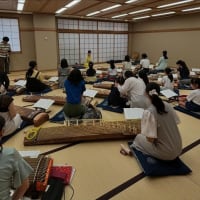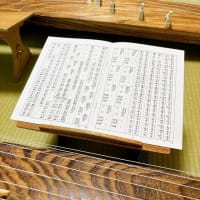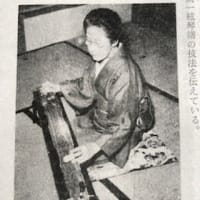
【English follows Japanese】
本日は、アッシュビルよりお届けします。
私たちにとっては普通のことなので
「指揮者なしにどうやって合奏するんですか?」
というご質問を受けて、改めて気がつきました。😱
確かに邦楽を演奏する際には指揮者がいません。
また、演奏の始まりや演奏中に、動作や音で合図したり、アイコンタクトを取ることもありません。
心を合わせ、間(ま)を感じて演奏致します。🥰
これは、昔のお箏、お三味線、琵琶の演奏家や作曲家のほとんどが目の見えない方達だったからかもしれません。
お合奏のお稽古では、演奏だけで無く、幕が上がる瞬間から降りるまでの一連の動作を練習することにも時間を費やしております。
幕が上がる瞬間から降りきるまでが一曲だとお習いしています。
ただし、オーケストラのコンサートマスター(通常は第一バイオリン)のように、
各パートにはリーダーがいます。 リーダーは「たて」と呼ばれています。
各パートは、たての方の音を聞きながら演奏し、たての方は他のパートの方と息を合わせて演奏していきます。
そのような観点から舞台を見られるのも興味深いかもしれませんね。
(文責:三上)
Posted from Asheville, North Carolina, USA.
It's normal for us, so when I was asked, "How do you perform without a conductor?", I was realized it.
There is no conductor when playing Japanese traditional music.
In addition, there is no action, sound, or eye contact at the start of the performance or during the performance.
Everyone foncusing on to feel the "Ma" (best timing) and play together.
This may be because most of the koto, shamisen, and biwa performers and composers in the past were blind.
Ensemble practice is not only playing music, but also we practice a series of movements from the moment the curtain rises to the moment it falls. We spend time to practice it. Our teacher though us that it is a music from the moment of the curtain rises to the end.
However, like an orchestra concertmaster (usually the first violin), each part has a leader. The leader is called "Tate".
Each part playing while listening to the sound of "Tate". And the each "Tate" playing in harmony with the other parts.
It may be interesting to see the performance from that perspective.
本日は、アッシュビルよりお届けします。
私たちにとっては普通のことなので
「指揮者なしにどうやって合奏するんですか?」
というご質問を受けて、改めて気がつきました。😱
確かに邦楽を演奏する際には指揮者がいません。
また、演奏の始まりや演奏中に、動作や音で合図したり、アイコンタクトを取ることもありません。
心を合わせ、間(ま)を感じて演奏致します。🥰
これは、昔のお箏、お三味線、琵琶の演奏家や作曲家のほとんどが目の見えない方達だったからかもしれません。
お合奏のお稽古では、演奏だけで無く、幕が上がる瞬間から降りるまでの一連の動作を練習することにも時間を費やしております。
幕が上がる瞬間から降りきるまでが一曲だとお習いしています。
ただし、オーケストラのコンサートマスター(通常は第一バイオリン)のように、
各パートにはリーダーがいます。 リーダーは「たて」と呼ばれています。
各パートは、たての方の音を聞きながら演奏し、たての方は他のパートの方と息を合わせて演奏していきます。
そのような観点から舞台を見られるのも興味深いかもしれませんね。
(文責:三上)
Posted from Asheville, North Carolina, USA.
It's normal for us, so when I was asked, "How do you perform without a conductor?", I was realized it.
There is no conductor when playing Japanese traditional music.
In addition, there is no action, sound, or eye contact at the start of the performance or during the performance.
Everyone foncusing on to feel the "Ma" (best timing) and play together.
This may be because most of the koto, shamisen, and biwa performers and composers in the past were blind.
Ensemble practice is not only playing music, but also we practice a series of movements from the moment the curtain rises to the moment it falls. We spend time to practice it. Our teacher though us that it is a music from the moment of the curtain rises to the end.
However, like an orchestra concertmaster (usually the first violin), each part has a leader. The leader is called "Tate".
Each part playing while listening to the sound of "Tate". And the each "Tate" playing in harmony with the other parts.
It may be interesting to see the performance from that perspective.



















